The main reason behind any business failure is its misalignment system to develop a successful sales strategy. Making a marriage successful requires balanced support from both the partners to build a healthy relationship. Similarly, sales and marketing are two partners wherein they need to walk parallelly in every aspect to make a business successful.
In simple terms, marketing needs to know about sales, and sales need to learn more about marketing.
Sales alignment is an activity where a salesperson needs to ensure that there is proper sync up with the marketing department. This alignment will further lead to enhancing sales enablement.
Implementing the following measures will help different organizations improve their sales and marketing alignment processes –
1. Finding new ways for remote selling
Consider a scenario where a transaction occurs without the buyer and seller meeting in-person, called remote selling, or even as virtual selling in basic terms. Also, the communication between the two parties happens irrespective of the location.
The pandemic has caused many workers to work from home; thus, many organizations have chosen remote working as a solution. Turned into new normal, remote working has made many sales organizations across the globe look for best practices that will help salespeople rise above these new hurdles.
Finding new solutions will help sales professionals conduct their customer conversations remotely.
2. Implementing data-driven insights
At present, big data and analytics are on the top list of the corporate agenda. Demand for timely delivery of the products is continuously increasing, making it essential for businesses to operate data-driven insights to achieve results.
The availability of data sources is growing each day. Leveraging this data helps sales and marketing teams outline more customer-centric experiences and obtain customer details in advance, this gaining enough time to plan for retention. Thus, being data-driven isn’t the goal, but in actual, it’s insights-driven.
Organizations must pull over the information and analyze it quickly to know consumers better and accordingly learn marketing campaign effectiveness. It will help them understand more of what worked and less of what may or may not work. Thus, every marketer must be aware of this phenomenon first-hand.
3. Reworking on virtual customer engagement
COVID-19 has revolutionized the meaning of “being digital.” It has raised many questions in the minds of salespersons – how to keep sales and marketing divisions healthy? How to stay at the top of the marketing and sales game in a time of deep consumer unease?
The answer to all of it is going virtual.
Giving virtual experience has become a must for consumers as it will help drive sales and growth for businesses. Companies must also look forward to developing a flexible, scalable, and cost-effective virtual operating model. Building a customer-centric approach to engage customers will make new ways of enhancing customer relationships with businesses.
4. Apply personalization to benefit the process
The organization that uses sales enablement tools to equip the sales team in delivering mass and quick communication is called personalization.
Personalization will be a prime point of sales-driving success in the upcoming years. It has already proven its strength in improving communication with buyers; B2B organizations can convert it into a positive shopping experience. And the best means to establish the connection is to combine the sales and marketing departments, thus increasing efficiency, speeding up the sales process, and improving accuracy.
Making use of sales data to personalize communication has been done for years. But there are always other options available when it comes to making a purchase. Many B2B organizations have proven that the more personalized a customer interaction is, the more efficiency the organization will gain.
Thus, personalization entails the consumer’s products they already liked and is often the key to bridging the conversion gap.
5. Increasing sales productivity
Targeting to focus on sales productivity is the prime concern of organizations. Everyday improvements in average rep and manager productivity increase the overall time of sales numbers spent on selling.
Working on streamlining workflow and eliminating unnecessary or superfluous tasks will lead to an increase in sales productivity. It is essential to know and define what steps successful reps take to win rather than preparing the salesperson with the newest gadget. Utilizing and sharing those strategies with the entire team can help organizations excel in it.
6. Use of video technology
Many marketers are moving toward video streaming technology to match up with the evolving tech world. It has become crucial for digital marketers to cultivate an understanding of video marketing. However, it has been observed that many marketers are still unaware of video marketing technologies for developing a sales and marketing strategy.
Continuous customer demand for convenient video technology has made many brands choose video strategy technology to create more awareness about their content.
Last words
Sales and marketing act like two sides of a coin when it comes to sales enablement. Sales enablement must be programmed dynamically to adopt all the new changes. However, maintaining the right balance between sales and marketing teams is a point of concern. It has to be strategically dealt with to derive the required revenues.
For more such insightful content access our latest whitepapers on sales and marketing and sales enablement here.








